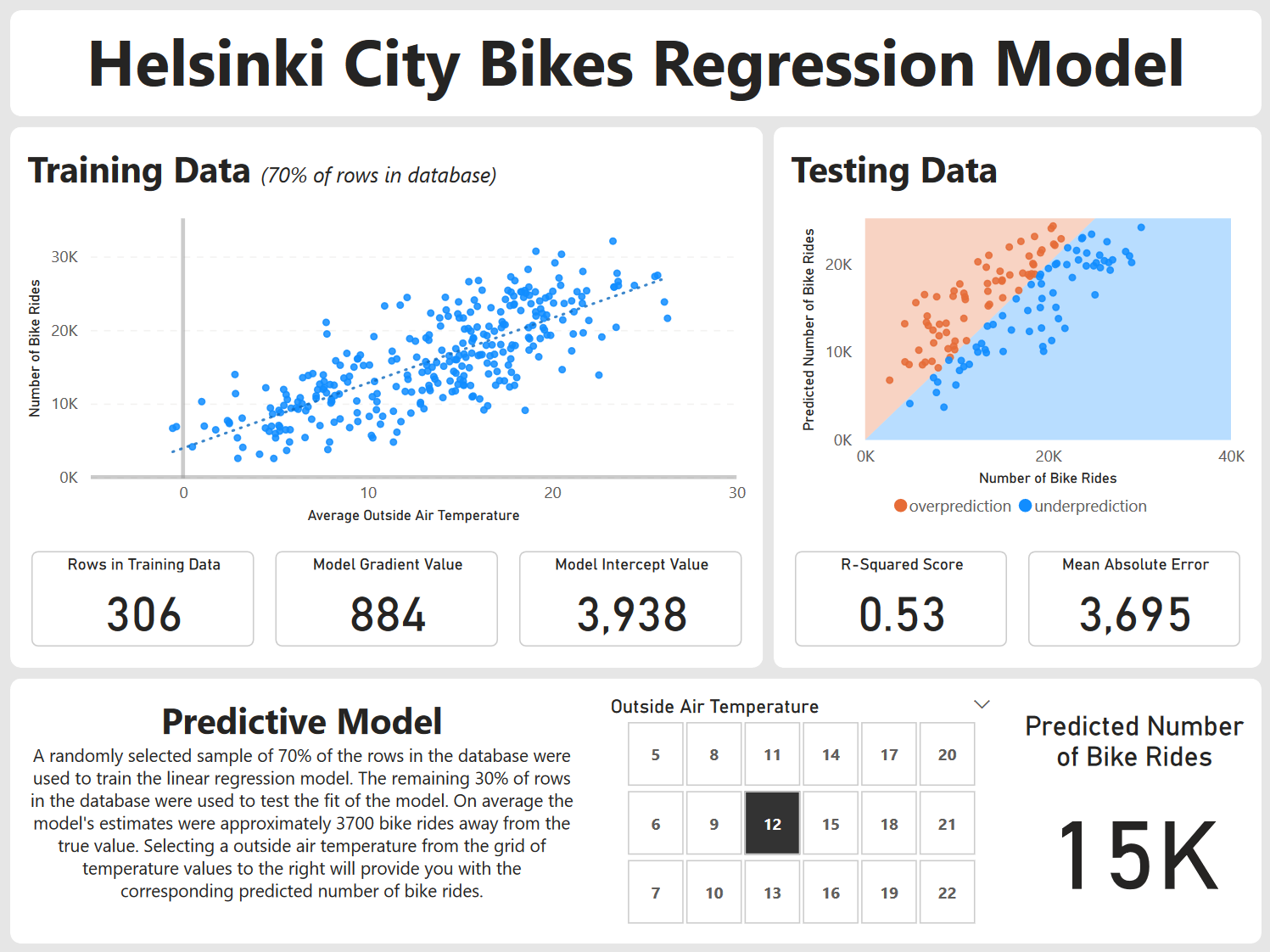Can Power BI be used to demo ML methods?
In this project a predictive linear regression model is constructed from stratch using Power BI. It uses the outside air temperature to predict the number of journeys taken on the Helsinki bike system, in the Helsinki and Espoo metropolitan areas of Finland. The project makes use of the Power BI’s DAX language to demo the train-test split method, an important safeguard against overfitting.
The resulting dashboard supports user inputs to allow for the user to interact with the simple regression model constructed. It also displays model parameters and evaluation metrics, all calculated using Power BI’s DAX language. Whilst this is an inefficient way to build ML models (the same outcomes could be achieved with a few lines of Python code), it is a nice tool for analysts who are more familiar with Power BI to build up their understanding of introductory ML methods.
Features
- Applied Power Query Editor steps to aggregate the data from the source to reduce the size of the imported data model.
- DAX Script to create two tables for the training data and testing data, using a 70/30 split.
- Data Visualisations of the training and testing data.
- Power BI What If parameter for user interaction with the final linear regression model.
Data Source
https://www.kaggle.com/datasets/geometrein/helsinki-city-bikes
Dashboard Screenshot

GitHub Repo
Code Extracts
Power Query M formula language
let
Source = Csv.Document(File.Contents("database.csv"),[Delimiter=",", Columns=14, Encoding=65001, QuoteStyle=QuoteStyle.None]),
#"Promoted Headers" = Table.PromoteHeaders(Source, [PromoteAllScalars=true]),
#"Changed Type" = Table.TransformColumnTypes(#"Promoted Headers",{{"departure", type datetime}, {"return", type datetime}, {"departure_id", Int64.Type}, {"departure_name", type text}, {"return_id", Int64.Type}, {"return_name", type text}, {"distance (m)", type number}, {"duration (sec.)", Int64.Type}, {"avg_speed (km/h)", type number}, {"departure_latitude", type number}, {"departure_longitude", type number}, {"return_latitude", type number}, {"return_longitude", type number}, {"Air temperature (degC)", type number}}),
#"Inserted Date" = Table.AddColumn(#"Changed Type", "Date", each DateTime.Date([departure]), type date),
#"Reordered Columns" = Table.ReorderColumns(#"Inserted Date",{"Date", "departure", "return", "departure_id", "departure_name", "return_id", "return_name", "distance (m)", "duration (sec.)", "avg_speed (km/h)", "departure_latitude", "departure_longitude", "return_latitude", "return_longitude", "Air temperature (degC)"}),
#"Grouped Rows" = Table.Group(#"Reordered Columns", {"Date"}, {{"Rides", each Table.RowCount(_), Int64.Type}, {"AvgAirTemp", each List.Average([#"Air temperature (degC)"]), type nullable number}}),
#"Sorted Rows" = Table.Sort(#"Grouped Rows",{{"Date", Order.Descending}}),
#"Filtered Rows" = Table.SelectRows(#"Sorted Rows", each [Date] > #date(2019, 1, 1))
in
#"Filtered Rows"DAX Scripts
RandomNumber =
// assign a random number to each row in order to randomly assign rows to the testing and training datasets
RAND()TrainData =
// Use 70% of the rows in the database as training Data
TOPN(COUNTROWS('Database')*0.7, 'Database', [RandomNumber], ASC)Gradient =
// calculate the gradient of the linear regression model
DIVIDE(COUNTROWS(TrainData) * SUMX(TrainData, TrainData[AvgAirTemp] * TrainData[Rides]) - SUMX(TrainData, TrainData[AvgAirTemp]) * SUMX(TrainData, TrainData[Rides]), COUNTROWS(TrainData) * SUMX('TrainData', TrainData[AvgAirTemp]^2) - SUMX(TrainData, TrainData[AvgAirTemp])^2, 0)Intercept =
// calculate the intercept value of the linear regression model
DIVIDE(SUMX(TrainData, TrainData[Rides]) * SUMX(TrainData, TrainData[AvgAirTemp]^2) - SUMX(TrainData, TrainData[AvgAirTemp]) * SUMX(TrainData, TrainData[AvgAirTemp] * TrainData[Rides]), COUNTROWS(TrainData) * SUMX(TrainData, TrainData[AvgAirTemp]^2) - SUMX(TrainData, TrainData[AvgAirTemp])^2, 0)TestData =
// Use 30% of the rows in the database as testing Data
TOPN(COUNTROWS('Database')*0.3, 'Database', [RandomNumber], DESC)PredictedRides =
// determine the model prediction number of rides for each row in the testing data
'TrainData'[Gradient] * [AvgAirTemp] + 'TrainData'[Intercept]MeanAbsoluteError =
// calculate the mean absolute error of the model
AVERAGEX('TestData', ABS([Rides] - [PredictedRides]))